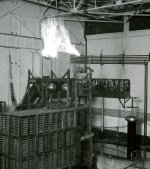

Newspaper writers observing a 1,000,000 volt, three phase, sixty cycle test. General Electric High Voltage Engineering Laboratory, Pittsfield, Massachusetts, June 5, 1923.
We had progressed perhaps 150 yards when the second stroke occurred. We were in single file and approximately 25 feet apart. As a result of the previous warning, all of us were carrying our rifles horizontally and in the lowest convenient position. At the moment of this second stroke, I was conscious of the simultaneous occurrence of several things. First, there was a brilliant background flash accompanied by a burst of corona streamers from the muzzle and front sight of my rifle. I happened to be looking in that general direction and distinctly observed this phenomenon. I felt a very intense, impulsive shock in my right arm, the one that was carrying the rifle, and felt a similar shock throughout my entire body. It seemed particularly severe in the region of my neck and might be likened to a rather severe blow from a rubber hammer, centered approximately at the base of the skull. My hat was knocked from my head, and I very distinctly heard the familiar sound of the impulsive corona streamers that not only formed on the muzzle of my rifle, but also seemed to form all about my head. I was knocked or fell to my knees, but was completely conscious at all times and recovered my feet almost immediately.
I was entirely aware of what had happened and made a conscious effort to remember in detail everything that occurred. The companion ahead of me froze in his tracks for a moment and then slowly turned about with a glassy stare in his eyes. I heard a low groan from behind, and as soon as I could command the proper muscles turned toward my companion in the rear. He was sprawled full length, face down on the ground, and his rifle was lying six or eight feet from his extended arm. He seemed virtually unconscious at first, and we approached him as rapidly as we could gather muscular control. I called to him and immediately thought of applying artificial respiration. As we approached him, however, he slowly rolled over, opened his eyes, and stated that his left leg felt as if it had been broken. We helped him to his feet and he stated that his right arm, which had been carrying his rifle and his left leg seemed to have borne the brunt of the shock.

